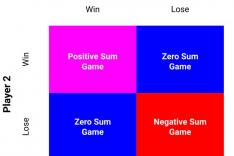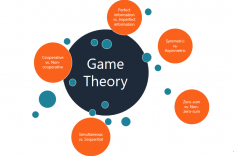Growth Through Innovation Series: Gamification of Innovation
Series Overview
This article is the sixth in a series about decoding the black boxes of innovation and incubation. Each article in the series is intended to be a self-contained unit, so please bookmark the first article in this series, so that you can find any piece you wish to see at any time.
Gamification for N00bs
I know, you're here to read about Hackathons. Yes, there is a section in this piece about Hackathons, and yes, I'll even help you skip to that section.
Ol' Reliable
Gamification used to be cool. It used to be special. It used to be one of the things in the innovation consultant's toolbox that could salvage a six figure contract when nothing else worked. It was perfect. It was reliable. It was Innovative. Now it's old hat. What happened? Is it still effective? Can companies still leverage the benefits of a gamify everything mantra?
The Background You Need
Whether or not you consider yourself an expert in gamification, I can guarantee that you've participated in it daily, willingly or not. Gamification is not simply "making a game" that a person is meant to play out of any experience. It is the application of game mechanics to non-game scenarios, which, I understand, sounds like the same thing, but it's not. It's better to think of gamification as "incentivised design." With incentivised design, each experience is comprised of actions that have a value, whether explicit and perceptible or not. In order to understand that value, it's best to have an understanding of game mechanics and game theory.
Game Mechanics
There are over a dozen recognized and fringe game mechanics, so for the sake of brevity (keeping this piece to 6,000 words instead of 7,000), we will focus on those most commonly used in gamification. These are the pieces of games that get repurposed to make customer experiences more enjoyable, more repeatable, more memorable, and more sharable.
Auction/Bidding
The principle of bidding typically goes hand in hand with resource management when it comes to actual games, but for gamified customer experiences, it is much simpler, and manifests in two forms. First is the direct application, which allows people to feel as though they have "won" something when making a regular purchase. This scenario also sets up sellers to be "winners" when their items sell for greater than the expected value. The second form of auction in gamified scenarios involves background algorithms and silent bidding, allowing participants from both the "selling" side and the "buying" side to enter a maximum or minimum acceptable value, and then get paired with each other mathematically.
The application of this game mechanic created a number of highly innovative software companies in the 1990s and early 2000s, and has generated untold billions of dollars in revenue from firms like eBay, penny auction sites, and RTB (real-time bidding) ad management platforms. RTB is such a prolific component of digital advertising, in fact, that RTB clearing houses still account for over 80% of advertising revenues. As far as its role in driving the "business of the internet" is concerned, this particular form of gamification is an absolute juggernaut for revenue. Whether there's room to innovate further with this form of gamification remains to be seen.
Cards
The Card is one of the oldest game mechanics, and while the concept often gets applied directly, the theory of a card is more important when it comes to its role in gamification. A card represents a single contained unit of a greater whole, and typically has explicit values that dictate what it does or how it is used. The concept of cards has been used in gamification as a means of tracking, as a means of redemption, and as a means of segmenting, with the goal typically being completion or collection of cards. Loyalty punch cards are the best example of the use of physical cards in the purest form as a means of tracking, redemption, and segmentation. In many cases, the loyalty card is a physical card that people carry with them until they have completed the list of tasks. It serves to define the tasks, keep track of progress, and become the redemption vehicle upon completion.
Another way people have applied the concept of cards to business innovation is with task management tools, particularly in the software development and customer support spheres. In the development process, and in the support flow, each card can represent one of hundreds (thousands) of available tasks, serving as a means of segmenting work. Developers and support staff tackle one card at a time, scoring "micro wins" when they complete them. Card completion when properly used in this context can even be a means of performance evaluation.
Randomization
Randomization is perhaps the most recognizable game mechanic outside of Turns. Shuffling cards, rolling dice, flipping coins, spinning roulette wheels, casting yarrow, and RNG(sus) algorithms are all versions of randomization. For the most part, in games and with gamification involving randomization, there is a targeted mathematical probability or a subset of available outcomes from which the randomization engine determines its outcome.
Innovation involving the application of randomization to regular processes is all but spent, but there is still a glut of opportunity for innovation when it comes to augmenting existing randomization algorithms, and for companies who can find ways to choose new and interesting subsets of outcomes. The goal of randomization in a game scenario is to introduce an element of surprise, and to add a lack of complete control that makes it possible for anyone to win. The latter has been leveraged to great effect in the gamification of millions of products, and has appealed to both a propensity for people to become addicted to the gamble, and to people's desire to score "wins" in otherwise predictable processes or scenarios (everyone loves getting lucky).
Resource Management
Resource Management is a key component of a number of games, and players who excel in this particular area are often expert-level players of dozens of games because of how integral it is to so many different types of games. Resource management is still relatively under-utilized in the gamification of products and processes, however, as it is a highly skill-driven component of game design. There is, therefore, a generous opportunity available to the company that can find the best way to apply this mechanic to a gamified experience. For those companies looking for ways to gamify process improvements, employing resource management goals and incentives to working processes could be a way to improve while also identifying employees with an exceptional talent that can be an asset to the company in ways not previously known.
Rewards
Rewards are among the most overt game mechanics found ubiquitously in digital products. Because rewards can be flexible and tangible, represent direct ROI, and make obvious the incentivised design to end users, nearly every company has an understanding of how they work. What many companies fail to grasp, however, is the absolute depth of application for this mechanic, whether because they don't fully capitalize on reward scaling, or because they don't consider the use of intangible or qualitatively measured rewards. For this reason, even though rewards are likely to be the most ubiquitously used mechanic for gamification purposes, there is still a significant gap between use and potential, leaving innovative opportunities in tremendous supply.
Turns
Turns exist in the game design pantheon with Randomization and Cards as truly fundamental components of the earliest games ever created. While we recognize the concept of a turn outside of games, it is also important to define turns within the context of gamification. For the sake of simplicity, a "turn" for gamified experiences is a segment of time within which a particular thing or subset of things can or must occur.
The use of turns in gamification is pretty easy to spot, and typically takes the form of delayed rewards or incentives for doing things on a regular recurring basis. Turns can be a tremendously effective means of incentivising repeat business or repeat usage of a product, and is a tool leveraged quite often in the interest of adoption of digital products. Turns also present an excellent opportunity to help companies gamify work processes, much like the way agile development methodologies employ sprints as a means of segmenting development.
Game Theory: Types of Games
Just as with game mechanics, there are well over a dozen recognized classifications of games in game theory, and just like games can combine multiple mechanics to create different games, so too can games combine different game types to create a different experience every time. With all of the different permutations available, it's no wonder game designers have been putting out hundreds of new games each year. The relative nascence of gamification in the business world therefore bodes well for opportunities to innovate through gamification.
Game Theory itself is an entire field of study; an incredibly complex and mathematically driven discipline that combines statistics, probability, mathematics, philosophy, and psychology. To suggest that this article will provide more than a conceptual introduction would be unfair to those who have devoted their careers to understanding, applying, and growing the field. The content herein is intended to help explain how gamification can foster business growth, particularly through internal product and process innovation.
The Sums
Where game theory is concerned, there are a number of different types of games, and the outcomes of those games can help to classify them in a series of buckets according to the type of "sum" their outcomes produce.
- Positive Sum Game: Positive sum games create a net gain that does not require either player to lose in order for anyone to win.
- Zero Sum Game: Zero sum games are those for which any positive outcomes require a negative outcome from another player.
- Negative Sum Game: A rare type of game in which all players lose, typically because of strategic choices.
Game outcomes certainly get more complex than the simple summary above, with factors like strategies and who plays each strategy coming into consideration. For the sake of simplicity, however, this article will focus on games that produce a positive sum. That is, when it comes to applying gamification in a business setting, it is best to invent scenarios in which there is a net positive outcome for all parties involved as opposed to creating scenarios that require any number of parties to lose in order for another to come out ahead.
The Types
Game types that are important in the context of gamification are those that outline how the participants interact with one another and with the game itself. For the most part, these are dichotomous splits, with hybrid variants factoring in on occasion.
- Cooperative vs. Non-cooperative: cooperative games are those in which players are able to form externally enforceable agreements or alliances; non-cooperative games are those in which players are naturally competitive with one another, or in which any agreements or alliances must be self-enforced.
- Sequential vs. Continuous: sequential games make use of turn sequences; continuous games allow both players to participate simultaneously.
- Determinant vs. Indeterminant: determinant games have an immutable and defined endpoint or end condition; indeterminant games have a targeted endpoint or end condition that can change as the game progresses.
- Symmetric vs. Asymmetric: symmetric games are those for which the player choosing a particular strategy does not affect the outcome of playing that strategy; asymmetric games have variable outcomes for the same strategies depending on which players play them.
- Perfect vs. Imperfect Information: for games with perfect information, all players are aware of all previous actions and all potential actions available to all players at all times; for games with imperfect information, some potential game-affecting information is kept hidden from one, many, or all players.
Game Types in Gamification Scenarios
The goals a company is trying to achieve through gamification typically prescribe the nature of the games to be created, and the mechanics to use. Adoption goals have a fairly hard-lined formula by now of being positive-sum games that employ turns, rewards, and perfect information as an archetype. With the background outlined above, the ways in which gamification can be a source of growth for a company should be shaping up to be rather obvious at this point. The only questions that should be left are:
- What outcome am I trying to incentivise by employing gamification?
- What are the best mechanics available for the delivery of that outcome?
Gamification in Business
A few examples of gamification being successfully leveraged in business applications have been outlined above, but after slogging through a brief history of the universe of game theory, it might make sense to summarize the ways in which gamification has been used successfully in business.
Badges
Badges, medals, decorations, or what have you date back to the beginnings of ranking systems in military and martial arts settings. Badges as they've come to be known in gamification, however, are more closely related to those invented by the Boy Scouts in the early 1900s, whereby scouts complete particular sets of tasks in order to earn particular badges. Fast forward to digital apps, which award people badges and different levels of those badges for using apps in prescribed ways. Badges provide an emotional investment in the "progress" of completion, especially when the tasks necessary to complete the badge are relatively easy to do. For fear of abandoning progress, people will strive for the pride and satisfaction of completing the task list. For many, some badges even provide a sense of validation when they can be displayed to the app's digital community.
App makers leverage the psychology of microdoses of serotonin via badge notifications. The little red numbers you see on all of your apps... yes, that's actually gamification at work. The more likes, comments, or notifications a person receives, the more microdoses of serotonin they receive, perpetuating an addiction loop that makes them seek more notifications. The sweet feeling of making those red notification bubbles go away: unbeatable. Your attention has been gamified.
Loyalty Rewards
Though loyalty rewards have existed informally for hundreds of years, with special treatment, open tabs, special pricing, and other things available for regular patrons of businesses, formal loyalty rewards programs didn't really get started until the 70s and 80s, when American Airlines introduced the first frequent flyer program (AAdvantage) in 1981 (we're ignoring the less real Texas International Airlines program, because it has since become Continental and then United), and Diner's Club introduced the industry's first formal loyalty program in 1984. Fast forward again, and loyalty rewards programs are so ubiquitous that it's nearly impossible to conduct a business transaction without scoring some kind of bonus points from a credit card company or the merchant. As data mining becomes more prevalent, these loyalty programs become tracking tools, logging the purchasing patterns of every customer over decades. The psychology of rewards programs prior to their ubiquity was the propensity for people to make value judgments based on rewards, either fully or partially earned. As people become more immune to merchant rewards, it will be interesting to see how these programs adapt to hold their audiences. There is a significant opportunity to innovate in this space, to the tune of billions of dollars for whomever can get it right.
Auction
Auctions are among the oldest forms of business transactions, and their endurance over time comes down to one simple piece of psychology: people love to win, even if the prize is the exclusive right to spend money on something. Auctions set up a scenario in which the scarcity of something is amplified, by calling attention to the number of people who want to buy it, therefore driving an increase in demand from those people. This simple leverage has helped auctions and bidding, the gamification of purchasing things, thrive throughout the history of art and antiquity sales, land, property, and livestock sales, all the way to Ebay and RTB ad servers. Credit where it's due... this form of commercial gamification is impressively well-branded, and appeals so much more than "competitive consignment."
The Psychology of Gamification
Each of the examples above derive value from the psychological elements of gaming, which (sorry to say) have been exploited to take advantage of the human condition. As with everything else, there is a relatively standard distribution of the effectiveness of gaming psychology on individuals, but the mean in this particular bell curve is much more on the highly effective end of the spectrum. People just collectively struggle to avoid the allure of gaming, game mechanics, and game scenarios applied to mundane things. It might not be a bad thing, but certainly is something to watch for as companies sink their teeth further into the use of gamification in all products.
Gamifying Innovation
Gamifying innovation can be an extremely effective way to bring about the natural democratization of ideas within a company. This actually harkens back to a number of the central tenets of part three of this series, which extols the virtues of incubating talent in order to bring about the kind of innovative change a company needs and has naturally available.
When employees at an innovative company or a company with a strong culture of innovation feel empowered, they make changes and submit ideas that they know they can take ownership of. There are a number of ways to gamify that experience for them, whether through the use of town hall badges and awards, time saved equals time off programs, and even things like performance based compensation incentives. For non-salaried employees in particular, gamification of process improvement innovation is one of the only ways to incentivise people to work more efficiently and develop processes that others can use to do the same. Challenging employees to raise the bar on their productivity without compensating them for their effort is a negative sum game for them, and one that they are incredibly unlikely to want to play.
Hackathons
The premium version of gamified innovation is, without a doubt, the hackathon. Hackathons by nature are fun, intimidating, exciting, and riveting high-pressure events that bring out the best in everyone who participates... at least when they are well-executed. A poorly conceptualized or poorly executed hackathon can actually have damaging effects to a company's innovation culture, which is why companies often prefer to compete in industry-wide hackathons instead of running their own internally. In addition to the administrative requirements, many companies simply don't have the experience to balance the goals, rewards, participation incentives, and game-making that goes into a successful hackathon. There are even companies that specialize in running hackathons simply because so many companies want to do them, but lack the internal innovation culture to make it happen.
What is a Hackathon?
Quite simply put, a hackathon is an event that brings a coopertition game scenario to the process of innovation. The goal is typically to solve a particular problem by crowd sourcing as many ideas and solutions as possible, then using the competitive elements of a game scenario to sharpen them as quickly and effectively as possible. The term "hacking" in this instance therefore refers to the creation of a better way of doing something, and not explicitly to the type of hacking that earns you a spot in Morpheus's crew on the Nebuchadnezzar.
Many people believe that a hackathon is explicitly for software programmers, and that they are puzzle games that identify the people with the greatest prowess. The Social Network is one of the best movies ever made in its category, and Aaron Sorkin's script effectively built the majority of its momentum around two distinct "hackathons," the first of which took place in a dorm room, where a drunk and recently dumped Mark Zuckerberg went on a coding binge that resulted in Facemash (fictional entertainment liberties taken). The second was a "true" hackathon that a fledgling Facebook employed to identify its first few employees by subjecting them to a coding challenge complicated by the consumption of copious amounts of alcohol. Scenes like this, and other computer hacking scenes from movies like Swordfish and Girl with the Dragon Tattoo have certainly painted the lens through which people working outside of the technosphere ingest and process the concept of hacking and hackathons. They do not, however, represent the totality of hackathons that occur in tech companies around the world.
Elements of a Hackathon
Hackathons that are done well have a number of things in common. The following list isn't necessarily a complete recipe for a successful hackathon, but it's pretty easy to map these elements to the most successful industry hackathons as well as to the most productive internal hackathons.
Compelling Goal(s)
Perhaps the most important driver of participation and interest for a hackathon is the goal or problem to be solved by the competitors. The more specific the problem, the more focused the solutions, but the more limited the potential pool of participants will be. As with product management, it is important to focus on problems that don't require much explanation because of their pervasiveness, but which also appear to be solve-able. Many of the most successful hackathons select broad directional goals that can be solved in a variety of ways, which allows people to relate to the problem and approach it from the strengths of their backgrounds. Successful hackathon problems:
- Are worth the time to solve
- Have significant upside when solved
- Are complex enough to have a wide range of solutions
Hype
Hype is right up there with compelling goals as a driver of participation. There are a number of ways to build hype, and a successful hackathon combines at least four of the following things (more is better!).
- Press! Internal is a must, external is even better.
- Pride: make sure there is a significant value to being able to say "I/my team won"
- Scarcity: hackathons should not happen all the time. There should be a buildup that makes them anticipated events.
- Regularity: while they should not happen all the time, they should always happen at the same time. Every year in the same month, quarterly on the last tuesday, doesn't matter- just make it predictable for people.
- Presentations: (see also: venue) end of event presentations should be EPIC. People should be proud to present the ideas they've been working on, and they should feel like their presentation has value to everyone.
- Spectators: whether through a live video feed of the event space, documentary historians, or designated viewing areas, people should be able to watch the hackathon, especially the final presentations.
- Swag: people love free stuff and commemoratives. People love event tees for cool events. They love to brag about working for a company that does hackathons. Give them cool, free stuff that lets them show off to people who aren't as cool or lucky.
Participation
For the sake of this article, participation will focus on internal hackathons. Participation is absolutely required in order for a hackathon to be successful. Many of the other measures are ways to ensure good participation, but the following are some hacks that help smaller companies or less culturally innovative companies get their hackathon game on point.
- Small teams: many hackathons allow individual participants, but the recommended team size is roughly 3-4.
- Many teams: whenever possible, the more teams a company can make, the better.
- Wide functional roles: bring people in from everywhere! Many companies make the mistake of locking hackathons off to tech teams, product groups, and sometimes marketing. Get EVERYONE involved.
- Explain roles: pursuant to the previous note, explaining the roles of team members can expand participation. When people realize they don't have to be a programmer or innovative thinker to contribute, they will be more compelled to jump in.
- Do a Draft: allow team captains to "draft" the available participants to their team instead of signing up as a team. This prevents super teams from forming.
- Leadership incentives: get buy-in from leadership to make participation in the hackathon part of company culture PTO packages. Give employees the freedom to devote the time to participation without consequences to their "other work."
Venue
The venue is the most flexible of the components of a successful hackathon, but getting these points right can elevate the feeling, encourage participation to a greater degree, and really make participants feel like the hackathon matters. Focus efforts on the following.
- Location: ideally, the event will take place away from the normal working environment. The cooler the place, the more excited people will be to participate, and the better the photos and videos will look for the next event's marketing materials. Find a place that will let you access the event space 24 hours a day. Lots of hackathons are 24-48 hour binge events, and people often stay up all night working on things.
- Timeframe: as mentioned above, the most popular hackathons are 24 hour and 48 hour binge sessions. People stay up, bond with their teammates and with other people at the event, and have a great time. Treat it like a sleep-away retreat, with sleeping optional. The presentations after binge hackathons are always a gas.
- Presentations: continuing on the previous note, and on the note from the hype section, presentations at the end of the hackathon are a huge part of the appeal of hackathons. People rarely have the chance to feel great and get recognition at work. Make the presentations as spectacular as possible. Any mix of "stage" and lighting that makes it clear that the focus of attention in the room is on the people presenting these amazing solutions to big problems. Presentations are basically the hokey pokey of hackathons, because the pride of the pitch of a solution... that's what it's all about.
- Vibe: it really should match the personalities of the people at each company, but hackathons do well with higher energy environments similar to those you'd encounter on the vegas strip. You never know what time it is inside a casino, just that it's always party time.
- Ambiance: much like the vibe, ambiance can really play into the way people feel about the venue itself. Check out some videos on Youtube of successful hackathons to get a feel for what kind of things are common.
- Food: ya gots ta have good grub. Honestly, food, snacks, drinks, junk food and healthy stuff... make sure it's out and available at all times. Cold pizza hits differently at 3:30am in the middle of a hackathon. People interact differently when they've had a beer or two (on the job?!?!), and team dynamics become more fun. The point is, regardless of what you choose to provide, make sure it's there all the time and that people can just go grab whatever they want whenever they want.
Support
Hackathons are events. Specifically, they are team building events that have some of the best in class ROI when executed successfully. Treat them as such, and invest in a showrunner and/or small event planning team from inside the company or contract it out. Production assistants are cheap if you have to hire them, and having event staff to keep things like food and drink, tools, materials, and other things available. The better the experience, the better the solutions, and the more excitement and hype for future events.
Be sure to also create some coaching materials ahead of time. These can be creative prompts for when there aren't enough ideas, narrowing exercises for when there are too many ideas, team cards for when dividing labor is too difficult, and other things that can help teams overcome roadblocks. See the next section (facilitating ideas) for more information.
Prizes
For many people, winning a hackathon is a sufficient prize. For others, and to sweeten the deal for the formers, it is always advised to have prize support for any hackathon. Prizes can be suited to the participants. A $30 Applebees gift card, for example, isn't likely to light the fire for a product manager making six figures. In that scenario, the gift card would more than likely just become a trophy that gets pinned to the wall, depending on how much of a troll the winner is. Prizes that are popular for successful hackathons include the following.
- Pride: if there simply isn't room in the budget for prizes, pride can be enough as long as the recognition is significant. Make sure the entire company treats the winners like rockstars for the week. Maybe give them better parking spots. Hang their pictures in a prominent location. Make it obvious that the entire company is proud of them for what they were able to do at the hackathon.
- Swag: everyone should get swag (see hype above), but there should also be special winners only swag, too. Have custom shirts made for the winners. Make them some kind of trophy, or add their name(s) to a trophy that changes hands every year like the stanley cup. Maybe a cool hackathon champions' backpack to help them carry the load of putting the entire company's innovation effort on their backs.
- Money: obligatory mention of the fact that people really like winning money in almost any amount.
- PTO: for companies that don't already have flexible work schedules as part of the list of employee benefits (hint), awarding additional PTO to hackathon winners is a fantastic way to reward everyone for their hard work. For salaried employees, this prize honestly costs literally $0 up to a certain number of days, which is why (hint) so many companies have made unlimited PTO and flexible schedules part of the standard benefits package.
- Exposure: table stakes in the prize support domain is exposure for the idea, and the prerogative to continue working on it as part of a team that brings it to life, and potentially to market. Many hackathon participants use these events as their way to develop their careers and immediately stand out to their employers.
- Investment: if the idea is good enough, it is almost always the case that the hackathon awards investment dollars or the opportunity to pitch the idea (with a more refined presentation) for funding.
Hackathon Structure: Facilitating Ideas
Roadblocks can make hackathons a miserable experience for some people, whether it's because they struggle to get their idea to a presentable state, or because they struggle with the team dynamics, or a multitude of other factors. It is always important to know what the most common roadblocks are, and to have a plan in place to address them as quickly and painlessly as possible. That foresight can really save the experience for so many people attending hackathons for the first time, and even has a great deal of benefit for veterans as well.
What to do when there aren't enough ideas
There are always exercises that can help people identify problems, the people who have those problems, and the value of solving for them. Good product managers excel in this area, so it might also be the case that each team needs someone with that skill set. Otherwise, a good show runner will have identified the sparks of creativity ahead of time, and can feed idea-starved teams brainstorming ideas.
- Personalize the problem: has anyone on the team experienced something similar? What was the worst outcome they can think of, anecdotally? What caused it?
- Personalize the solution: has anyone on the team experienced a great solution to the problem? What were the limitations of that solution? What has changed since then that might make it viable or better now?
- Ideal world scenario: given limitless resources, what does the future look like? What is the first step on that path? The second?
- Walk the problem back to the beginning. Trace it as far as possible. Find the source(s) of the problem. What preventative measures could have been taken? Is there a solution that addresses the root cause instead of the symptoms? What does that look like?
What to do if there are too many ideas
An abundance of ideas is always a good problem to have at a hackathon. Time, however, is often the most precious resource, so sifting through them all, or spending too much time deciding which to develop can kill a team's momentum. Some of the more successful show runners have the following as advice to give.
- Zoom out and Merge: zooming out means looking at the idea from a non-detailed perspective. What is the idea actually doing? What is it solving for? Analysis like this can help teams merge multiple ideas into one according to how similar they are.
- Time horizon: how effective is each idea at different periods of time? Day 1, Year 3, Year 10, Future Generations? Which ideas are immediate solutions, and which are long term? Which ones have immediate ROI, and which ones don't?
- Points: quite simply, give everyone the same number of "votes" (typically half the number of ideas rounded down is a good number of votes per person), and allow them to assign points to each idea. They can put as many points on each idea as they have points to spread. The idea with the most points moves on. If there's a tie, eliminate the other ideas and vote again.
- Run an Idea Auction (see below)
Idea Auctions
Idea Auctions are actually a commonly used tactic at the start of a hackathon, and also a great way to build teams. Prior to starting the hackathon, allow everyone to submit any number of ideas to the show runner, who will organize them into an auction list. Once all of the ideas are on the board, participants will pick on the ideas they wish to work on for the hackathon by voting with points. This helps avoid a scenario in which the best ideas aren't worked on by the people who could contribute the most to them, whether because of subject matter expertise, or because of some other factor. It also prevents the scenario in which multiple teams present the same idea at the end of the hackathon.
When an idea auction is employed to solve a problem of having too many ideas, typically what will happen is the person who has the "extra" idea will put it into the auction pool. If another group (with too few ideas, or ideas that aren't as good) wants to use that idea, they can either trade a member of their team for that person, or simply take that idea and run with it. The "auction" part comes into play when there is a highly competitive environment, or when there is a cash prize on the line, and groups are willing to share a percentage of the possible winnings with the team that gave them the idea. The team that bids the highest percentage share will get the rights to the idea.
Expert Time
Hackathons are very interesting in that they have been going on for a long time, but very few people have actually participated in one. For this reason, expert time is a great way to help teams make the most of their experience, especially if they're new to it. Experts should be available, like coaches, for specific periods of time throughout the hackathon. Each team should have the opportunity to consult with an expert. That can be a subject matter expert (whenever possible), a hackathon expert (someone who knows how to win, shape ideas, and prioritize work), or a presentation expert (who can help people organize their ideas and pitch).
Micro Games
While the main focus of the event is the hackathon itself, many companies choose to have micro games or auxiliary goals that have their own prizes, judging criteria, hype, and objectives. Many companies consider these micro games to be a distraction, but in my personal experience with hackathons, they are a welcome addition for a number of teams and individuals.
The most common micro game is to award the best working prototype if that is not a requirement for the hackathon. Any team that can actually create a prototype in 24-48 hours deserves recognition, even if it's not very good. Judging the working prototypes against each other gives some teams a chance to win twice, but more often provides teams other than the hackathon winners to get recognition for their achievement.
Another common micro game is the awarding of superlatives. Things like "most unfeasible great idea," "team with the least sleep," "best in show," "smartest idea," "most empty cans of mountain dew" and so on are incredibly common at hackathons. They add a bit of levity to the event, and allow people to include as many people as possible in the recognition of their participation.
Finally, there is the incredibly sophisticated hackathon micro game known as side questing. These are special puzzles, participatory games, completion quests, and other non-main event related tasks that pay out rewards that are beneficial to the teams that complete them. Prizes include first choice of presentation order, immunity during elimination rounds (if there are any), special swag, and smaller prizes (like that $30 applebees card).
The Endgame
Deciding whether to pull the trigger on hosting a hackathon requires a company to consider dozens of factors, and to make a multi-event commitment in terms of financial resources, labor hours, and administrative planning. The best thing a company that is planning to host its own hackathon can do is to assemble a team or two internally and enter hackathons within their industry or even outside their industry until they win one. Getting an understanding of what it takes to win, and also seeing what things work well and which things don't will go a long way in helping that group spearhead the development of a successful hackathon internally. As much as this article can do to help companies move in the right direction, there is a tremendous amount of nuance that only a professional assessment from hackathon veterans can properly accommodate.
GSE has plans to host its own hackathons in the future, so if there is any interest in participating, either as a spectator, judge, hacker, or otherwise, please reach out to us using the form below.
Wrapping Up
Each article in this series is a self contained unit that is intended to help companies of any size become better innovators and cultivate more innovative teams and work environments. If we can provide any additional clarity or assistance with any of the content you find in these articles, please reach out any time and reference the Growth Through Innovation Series.
















